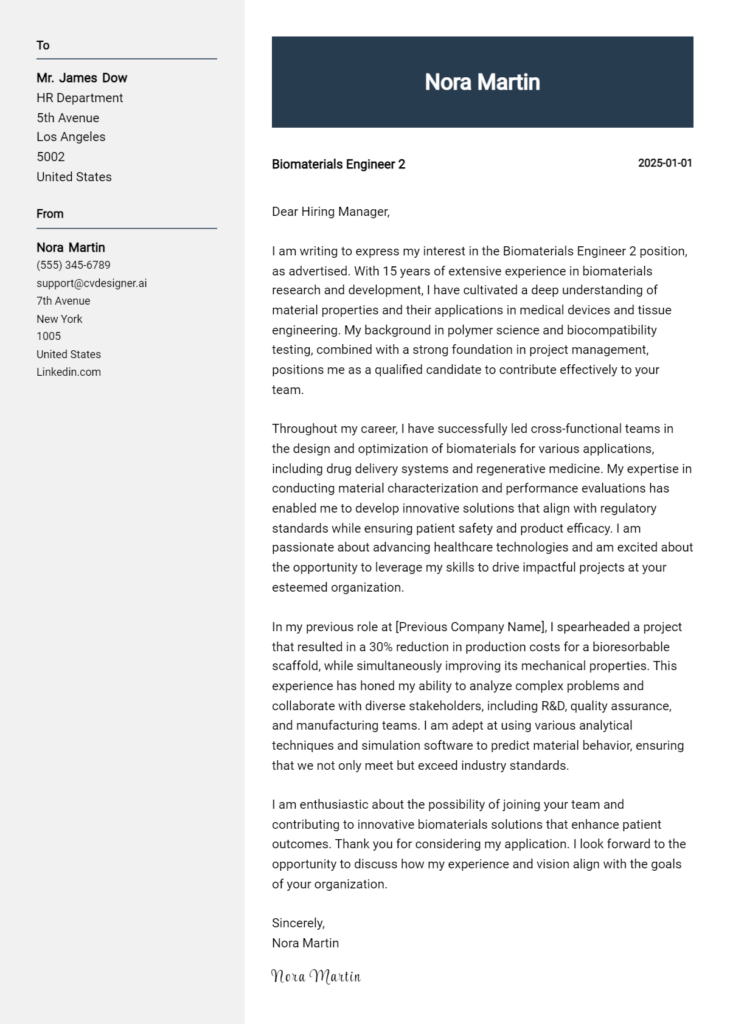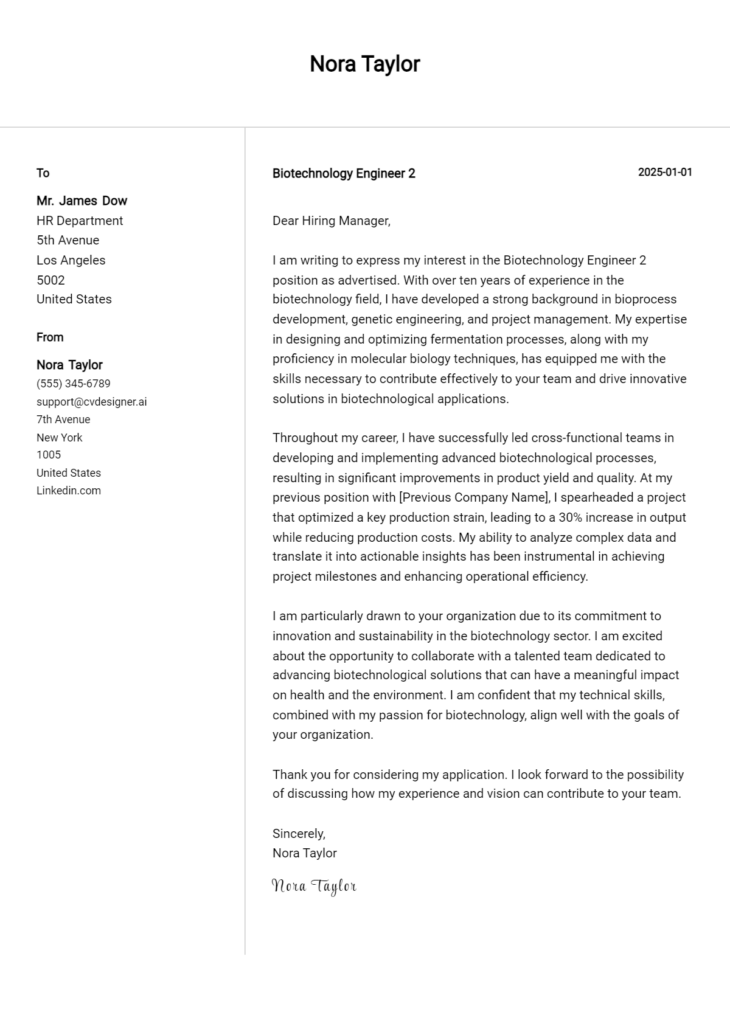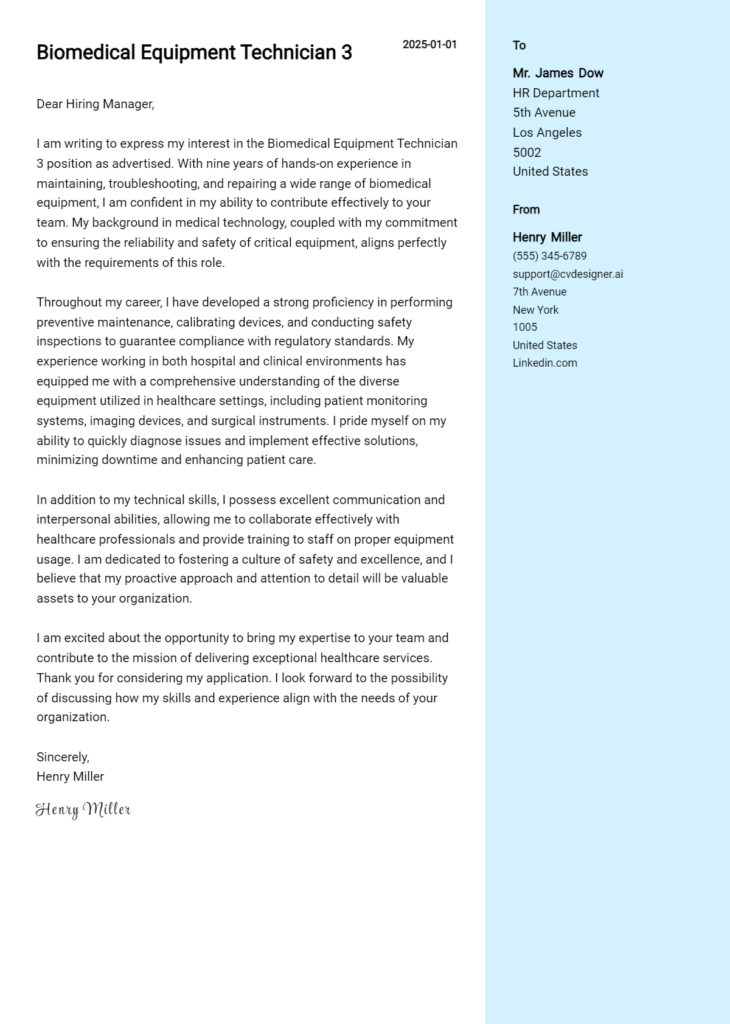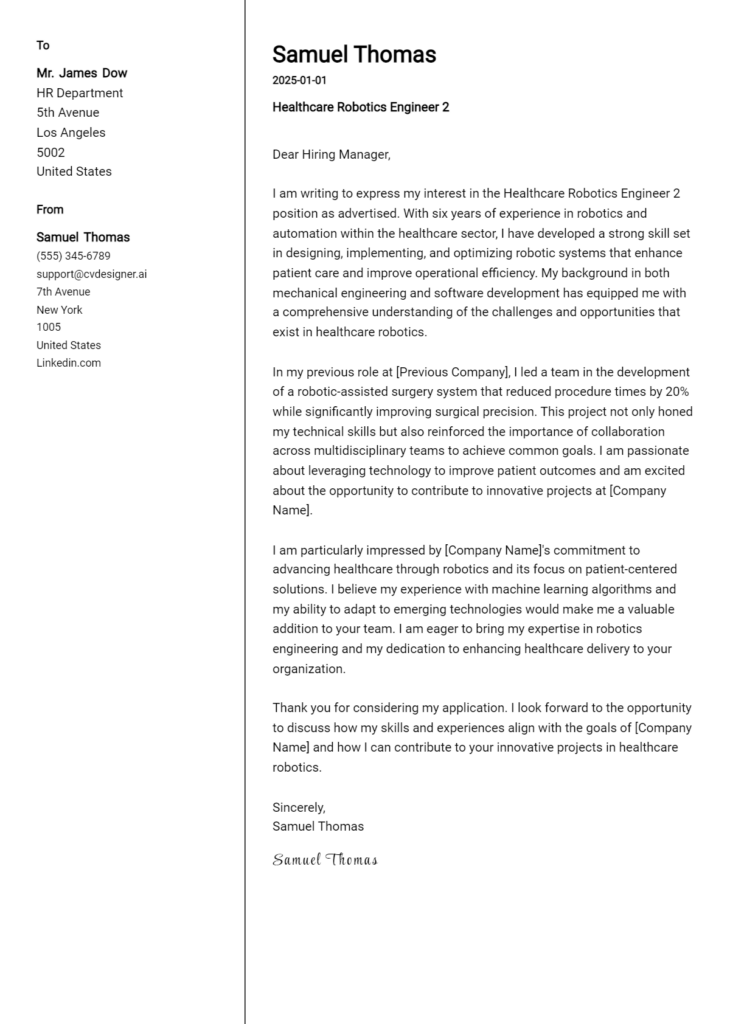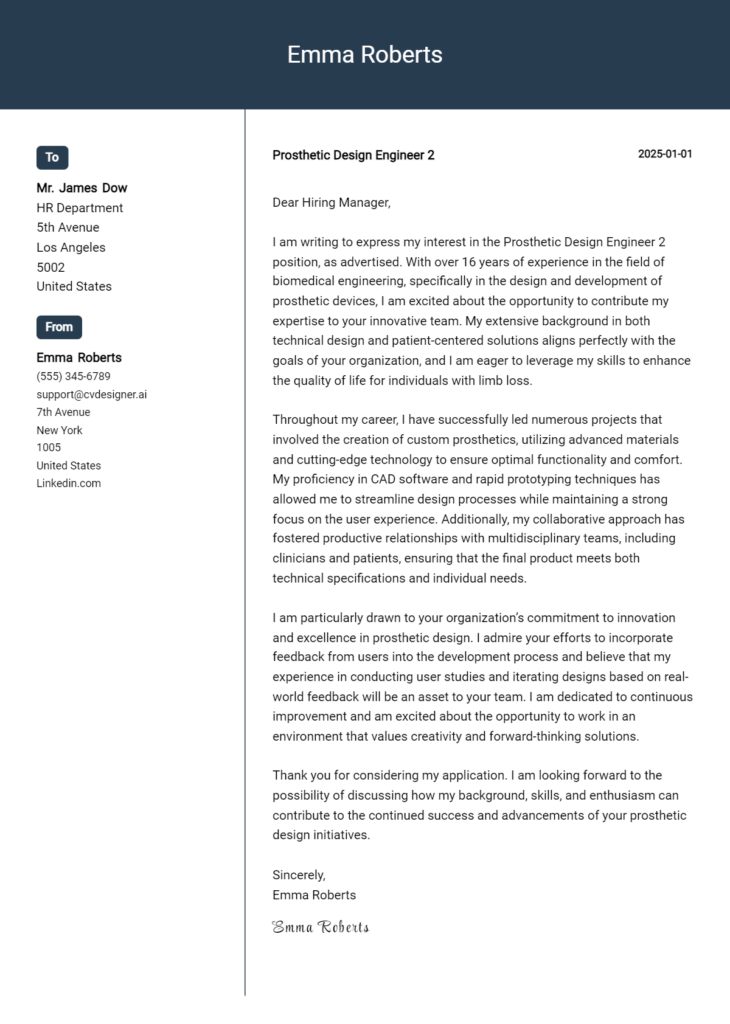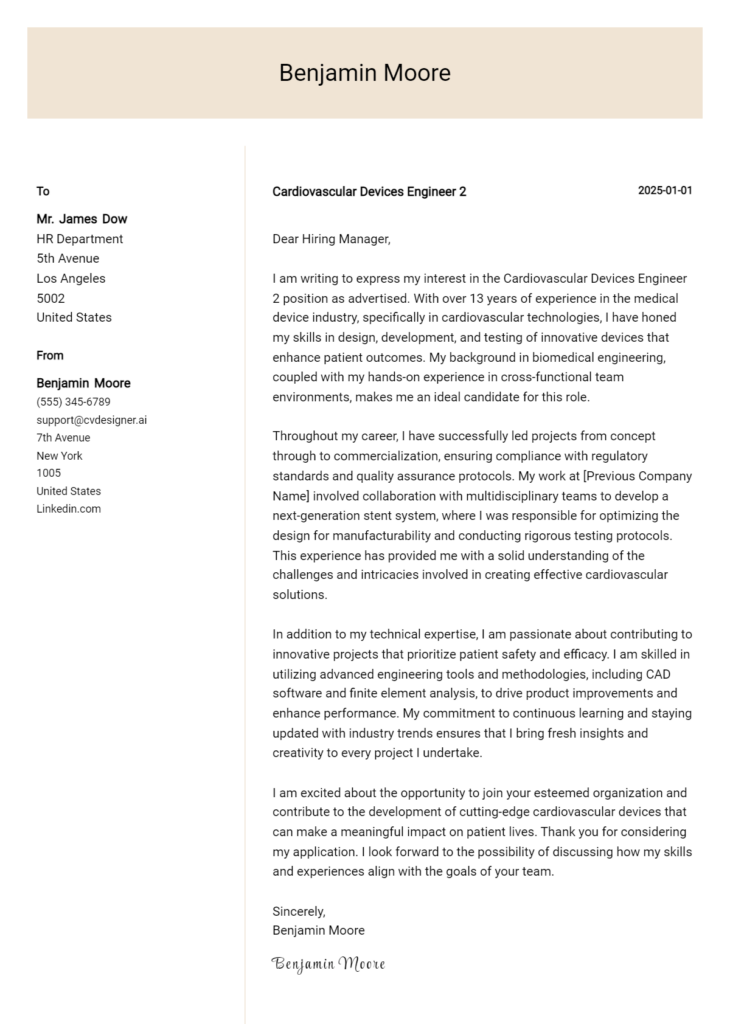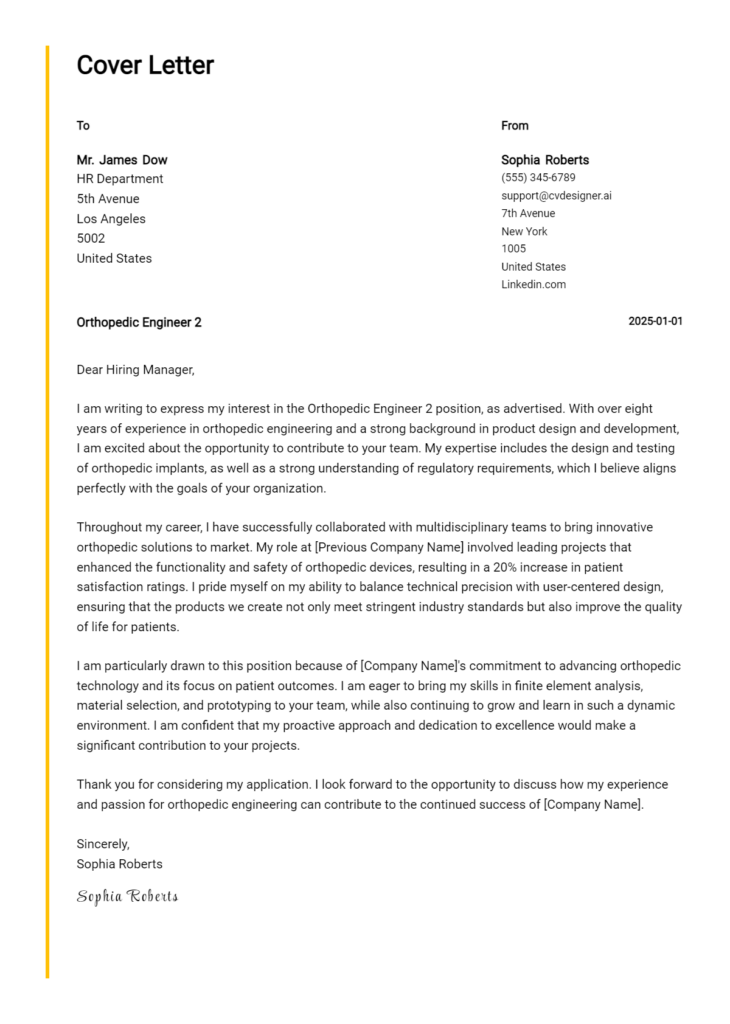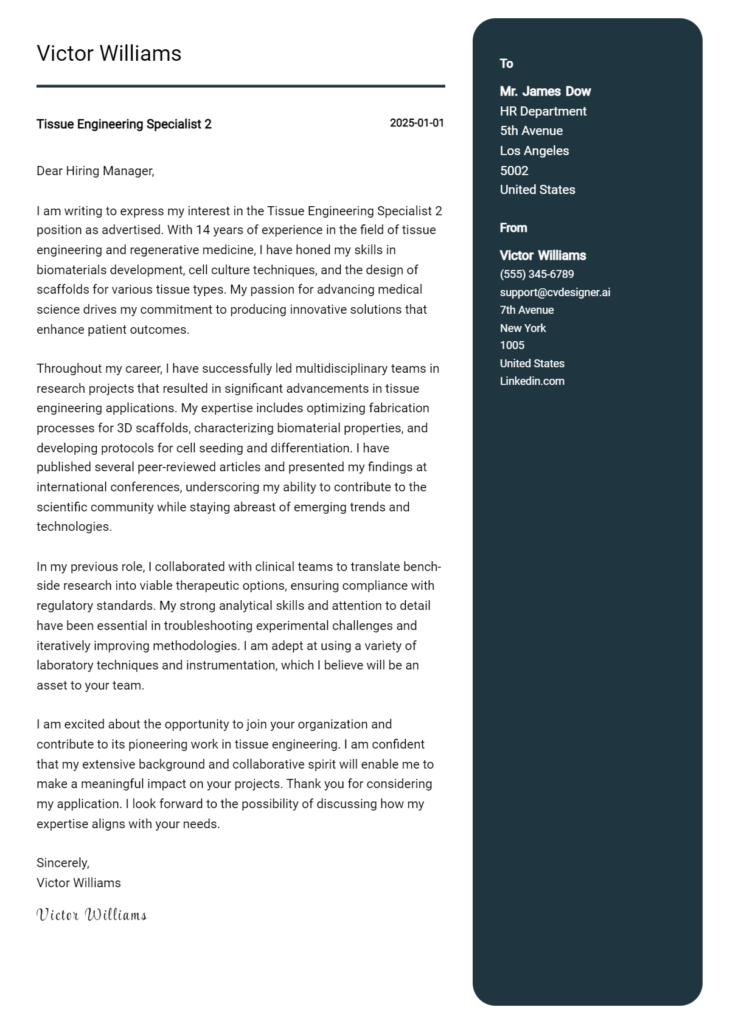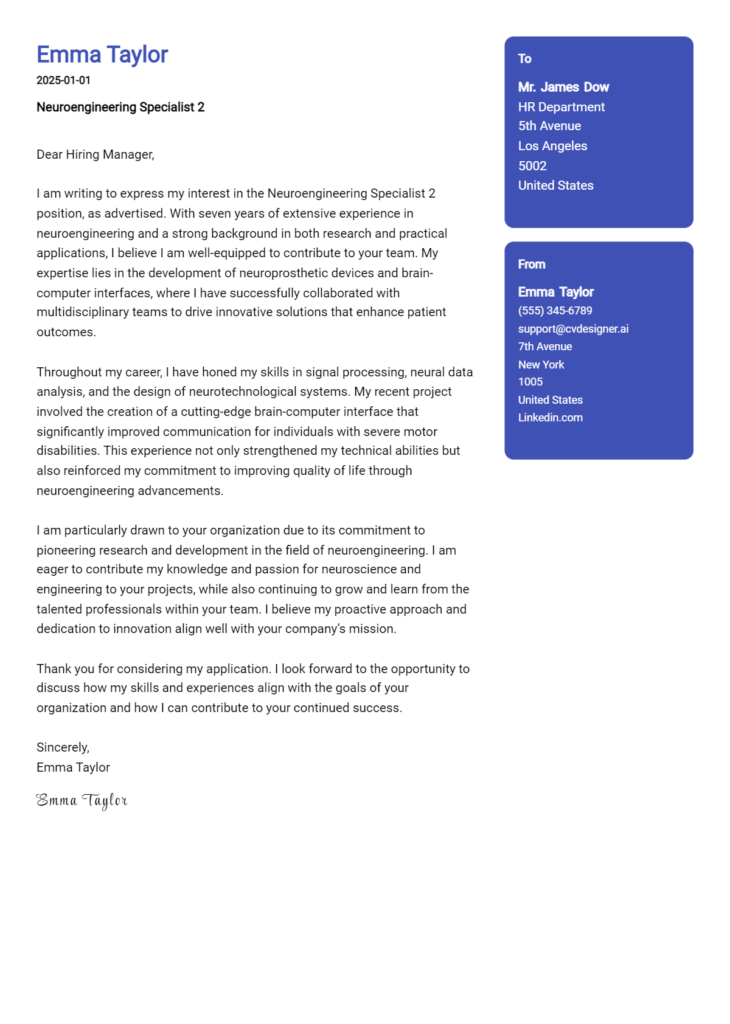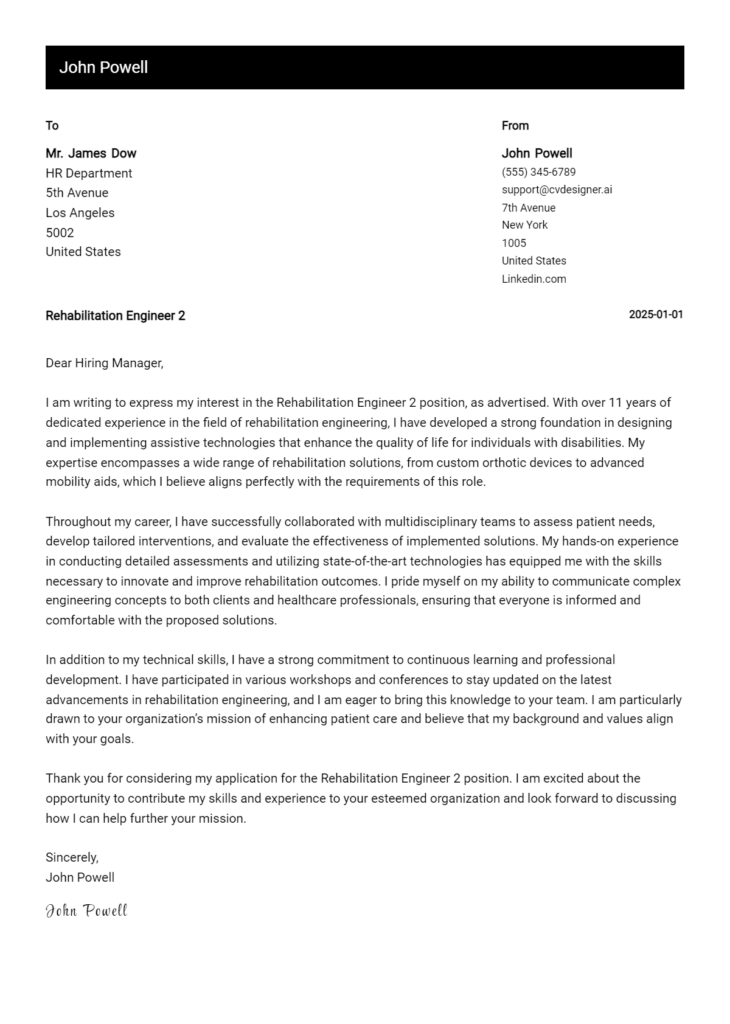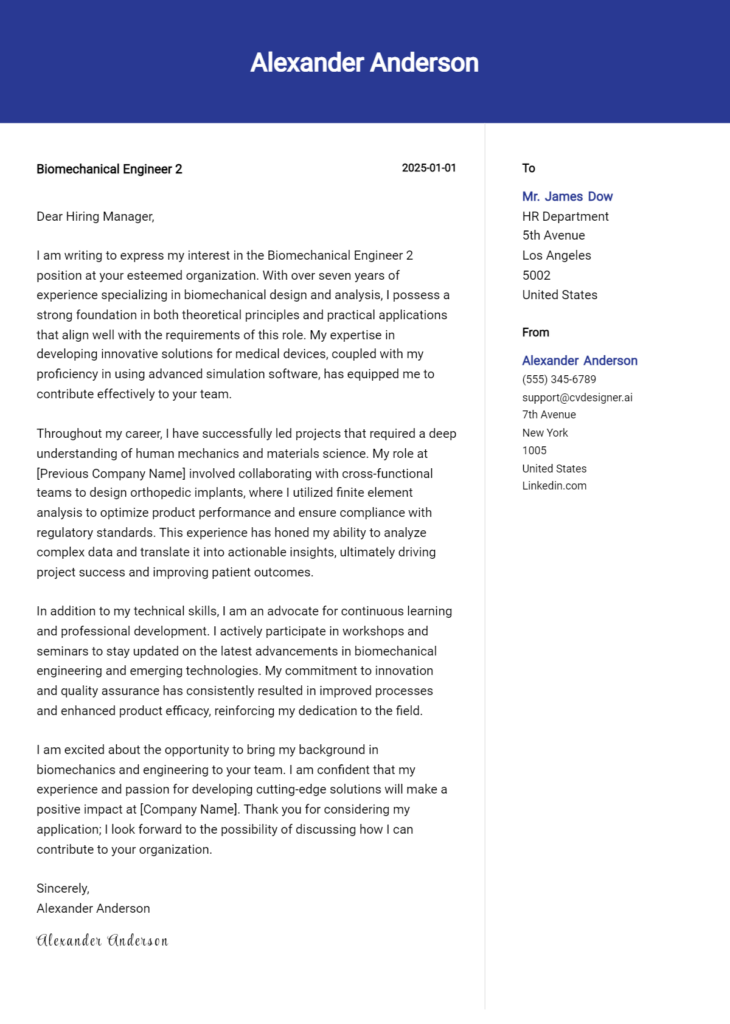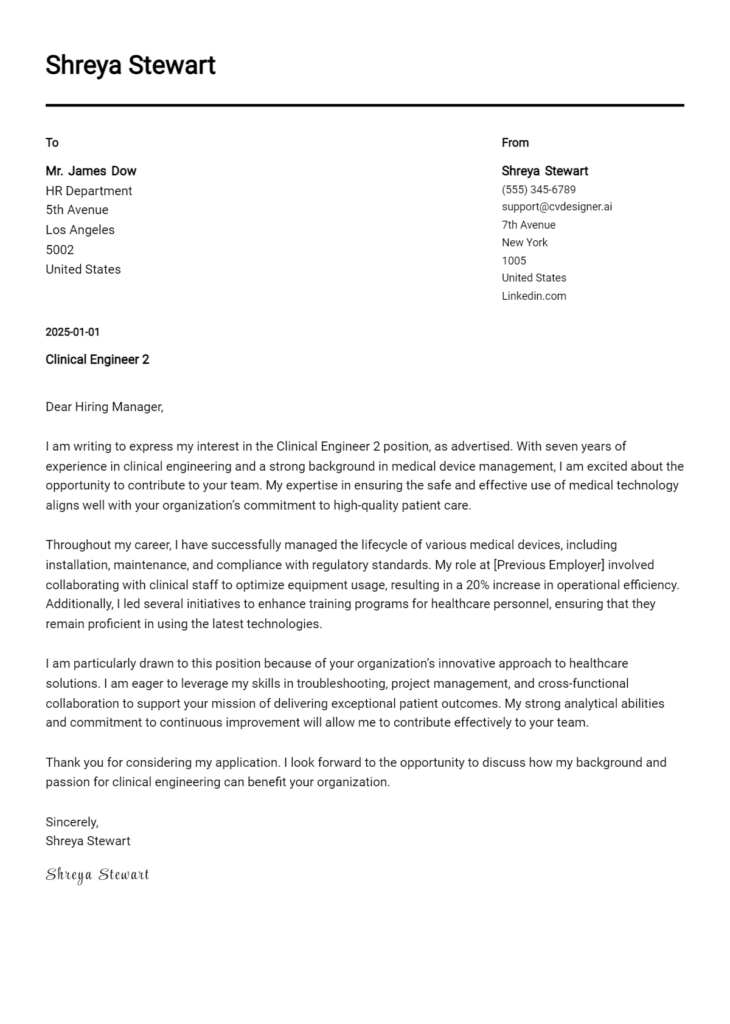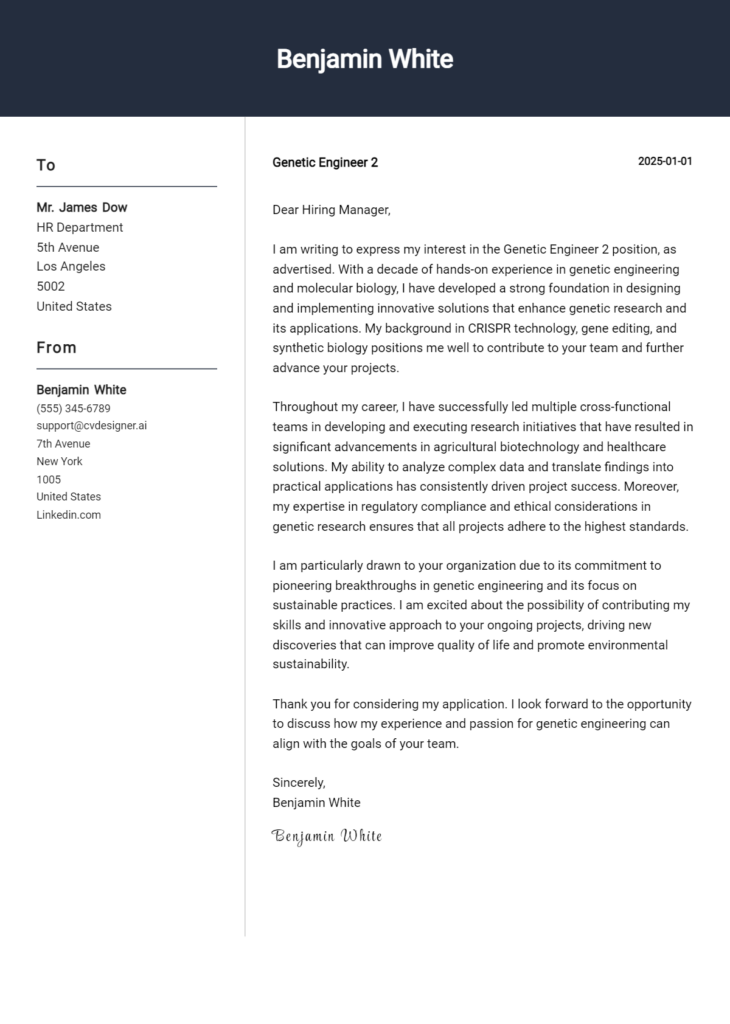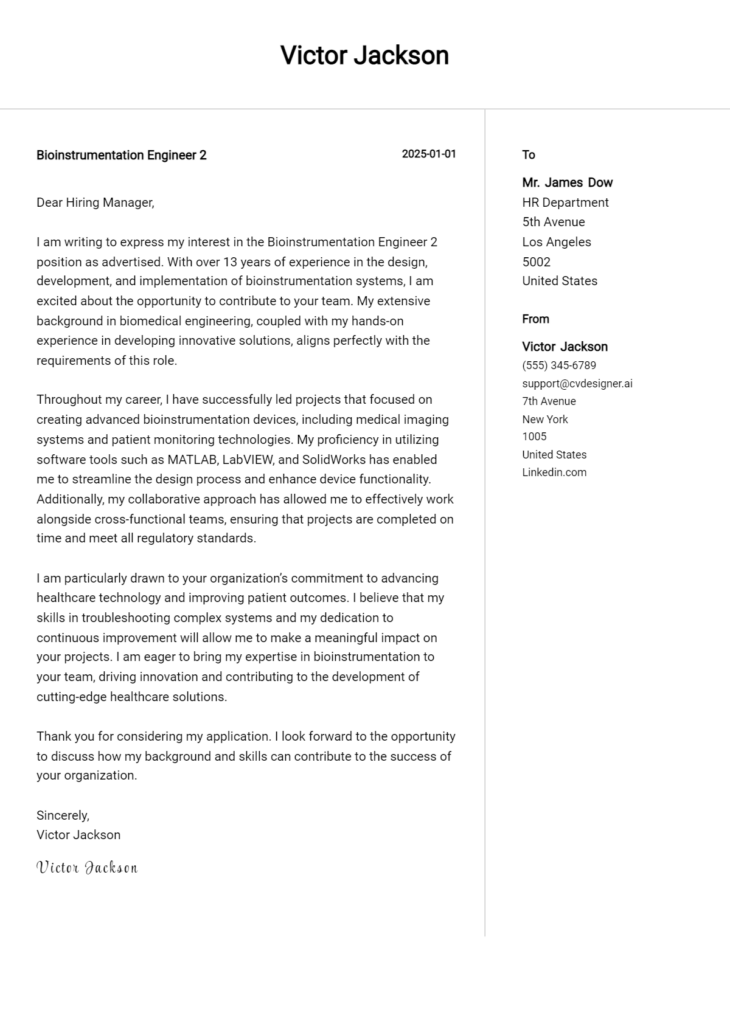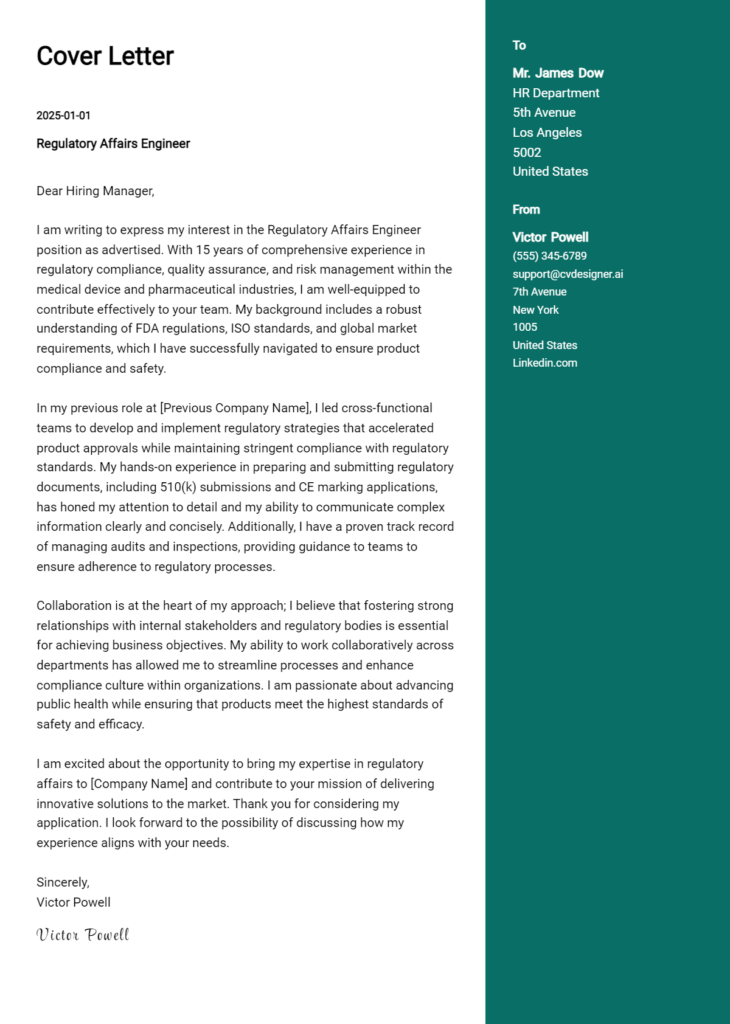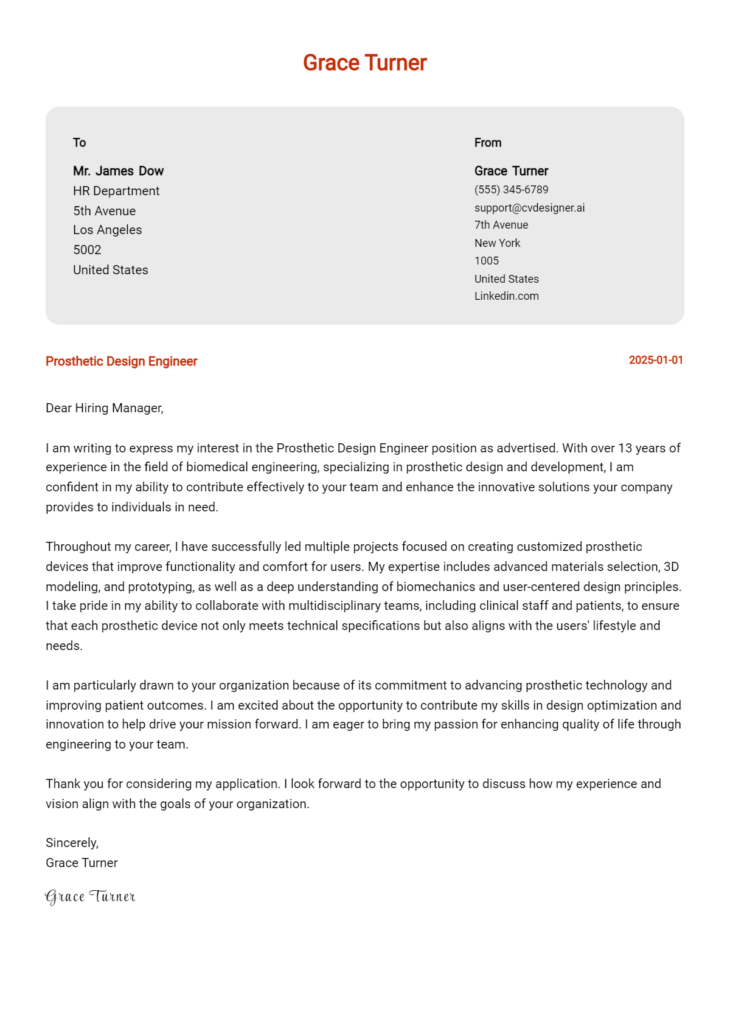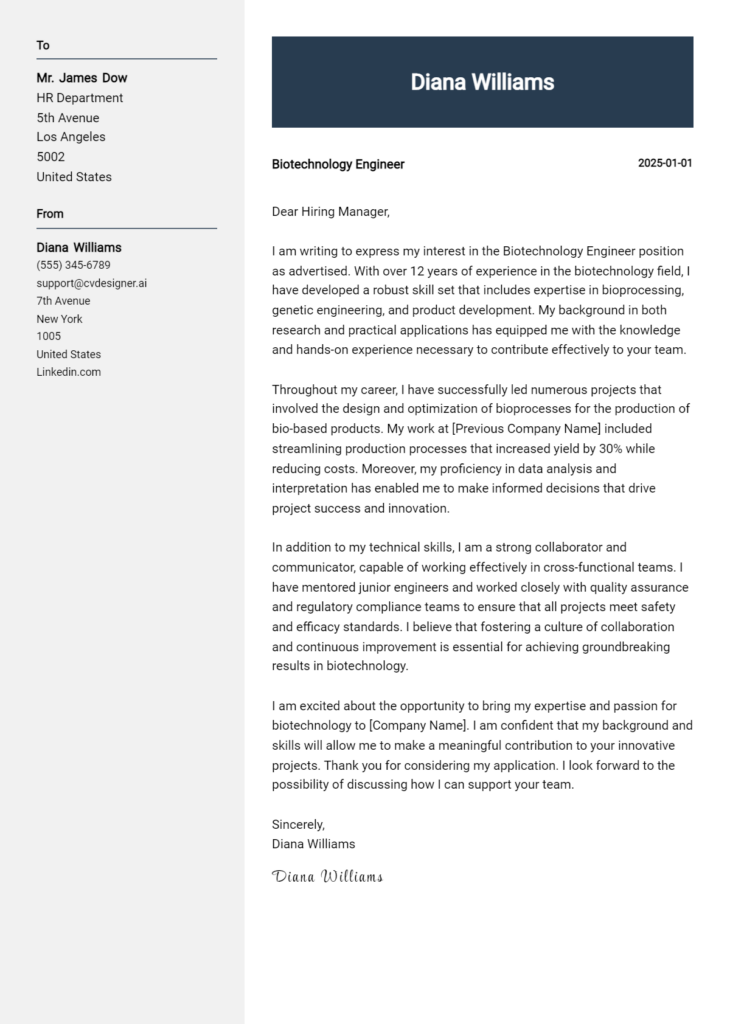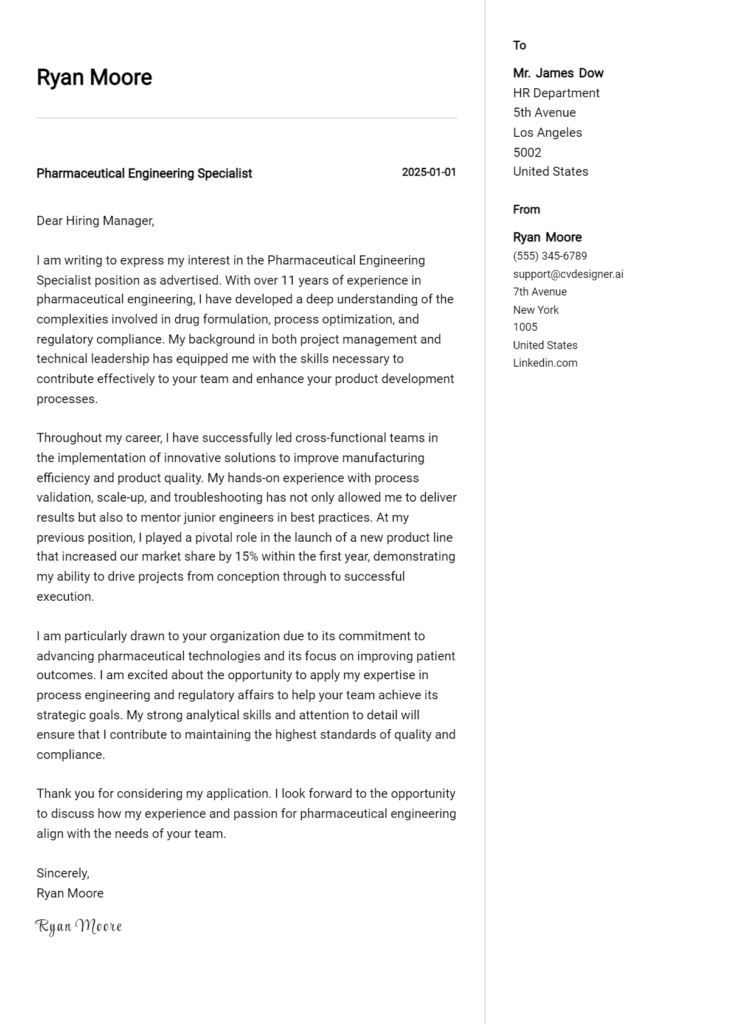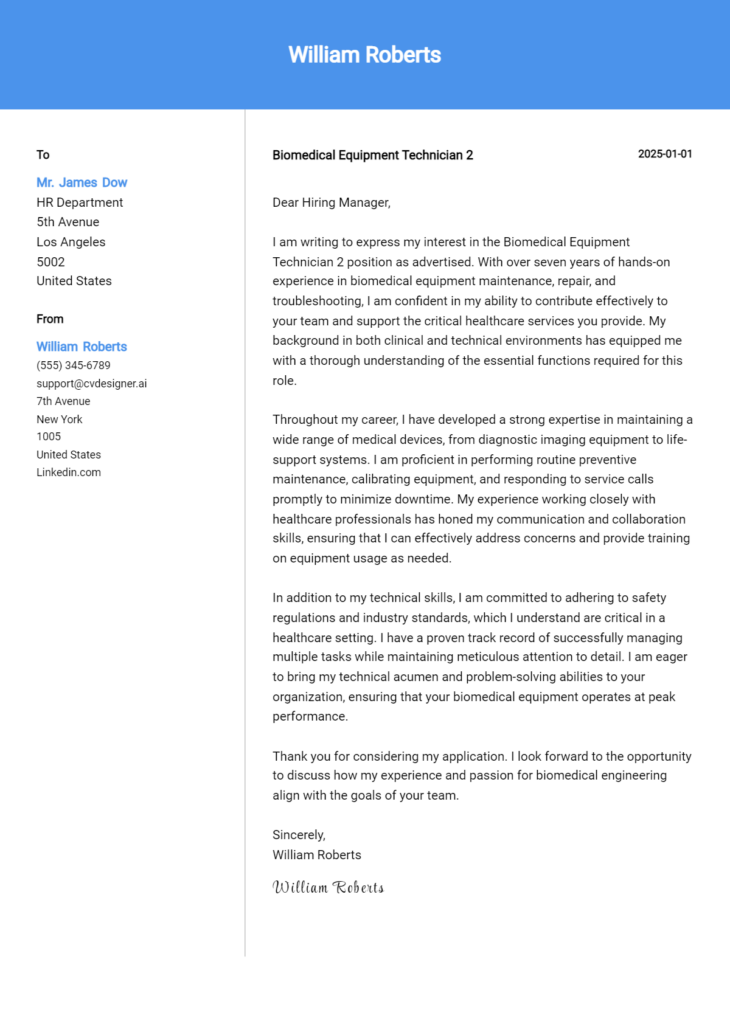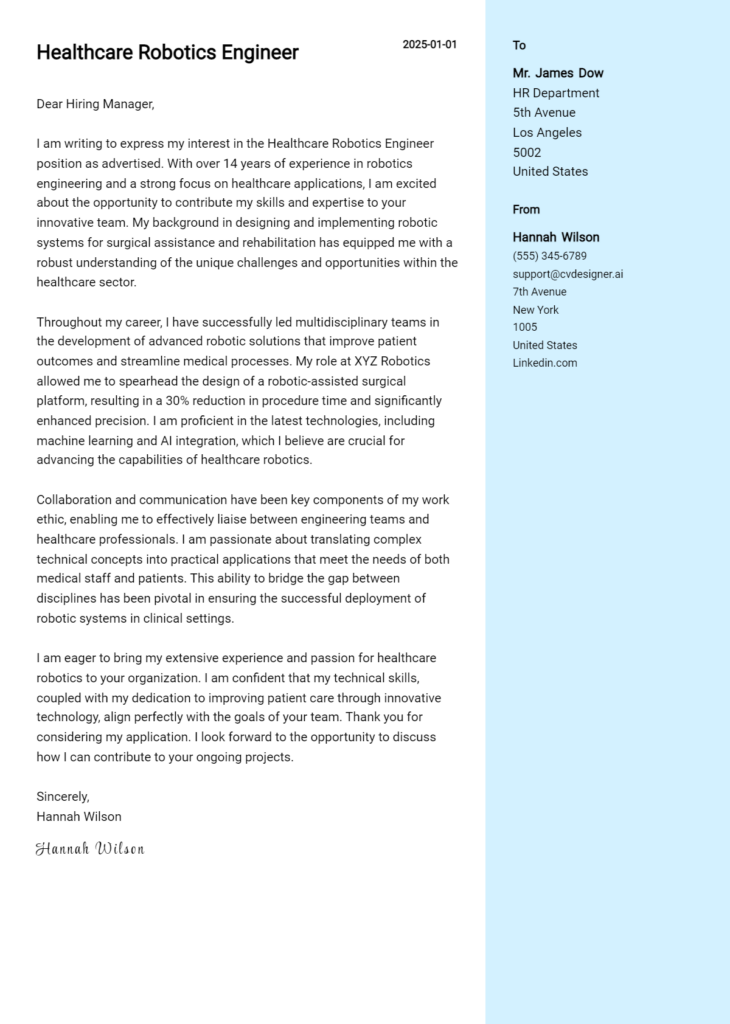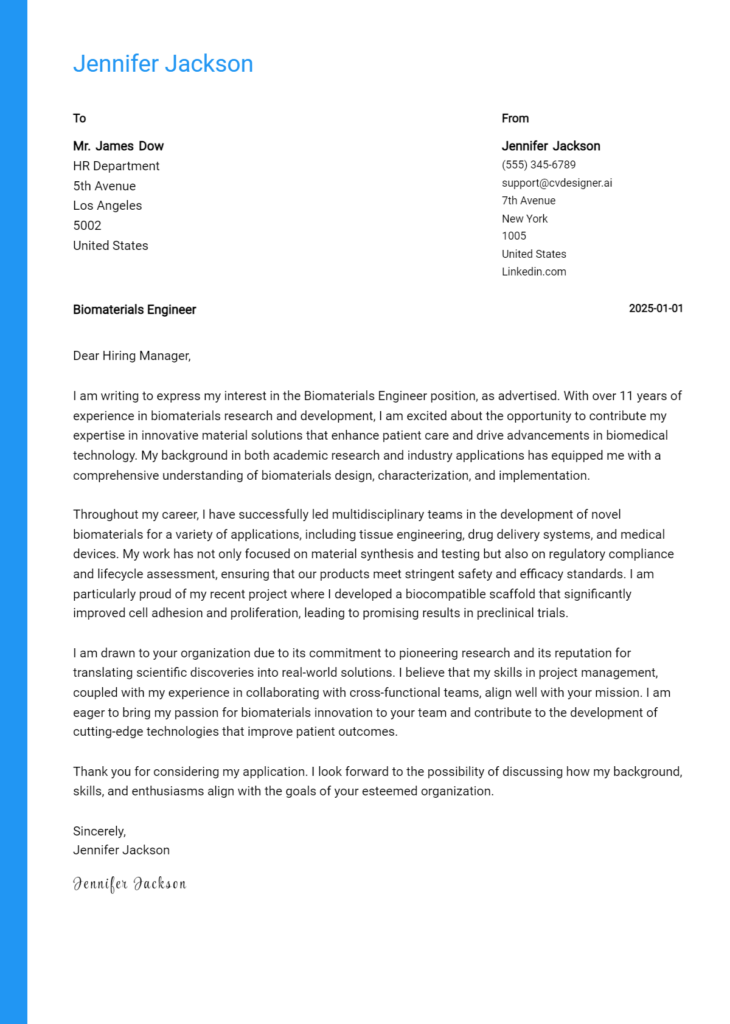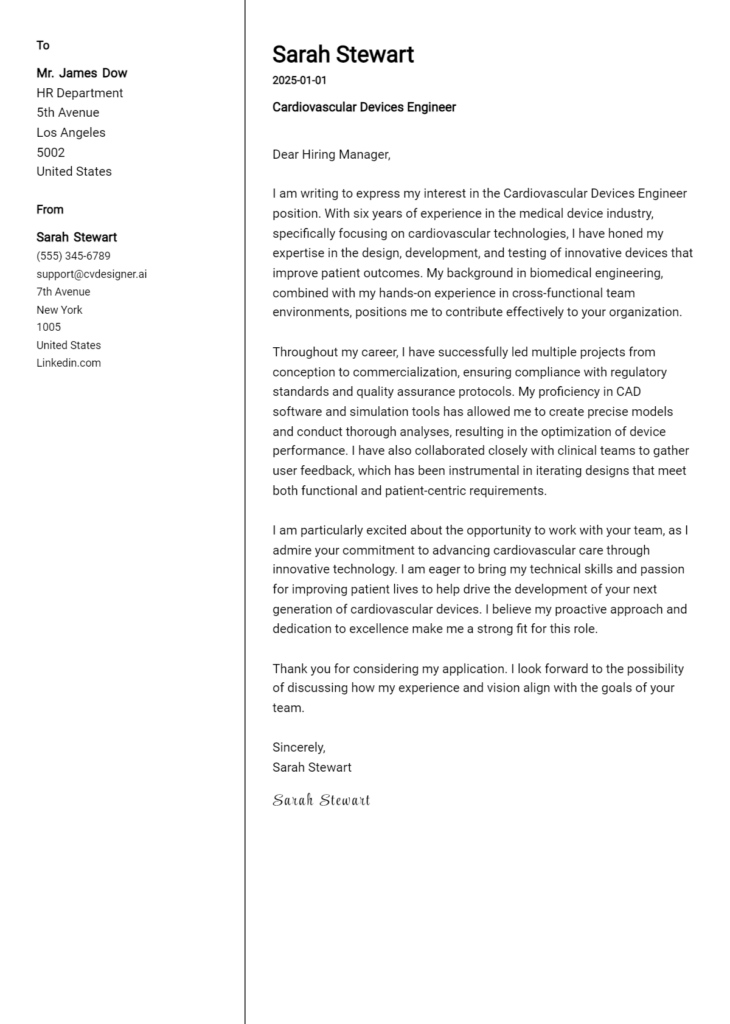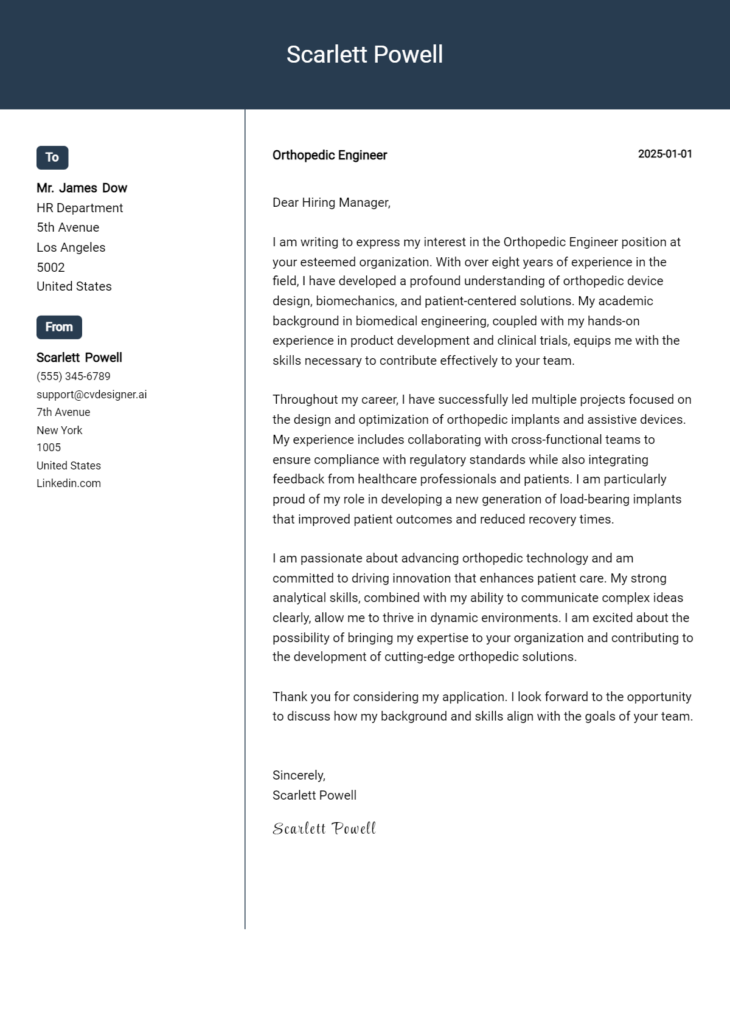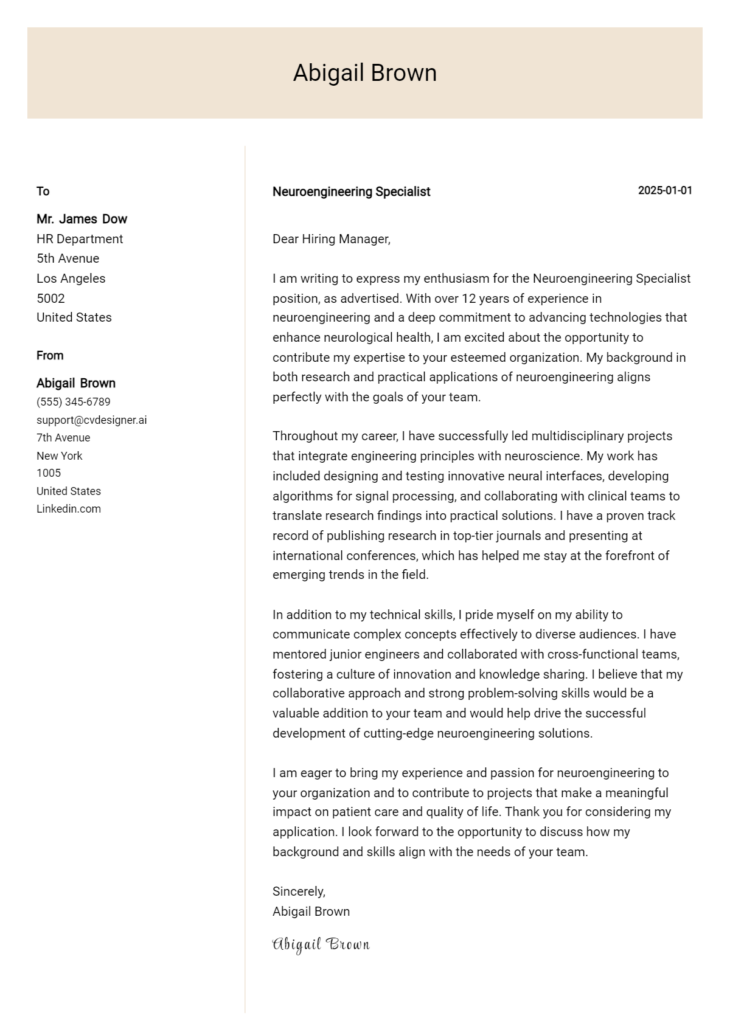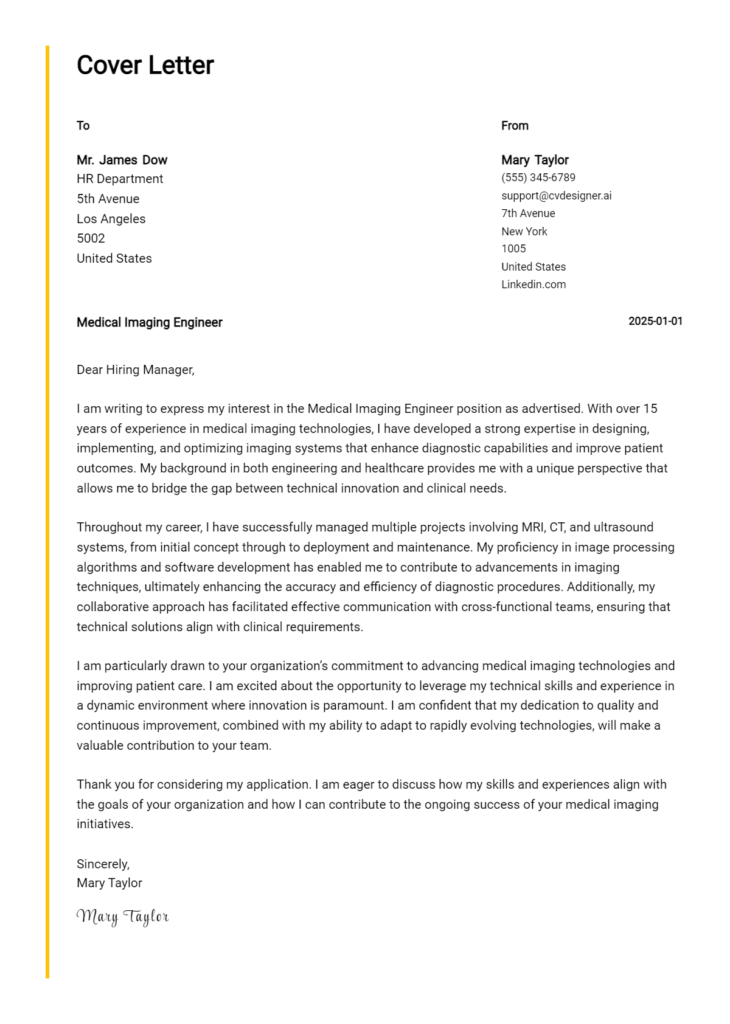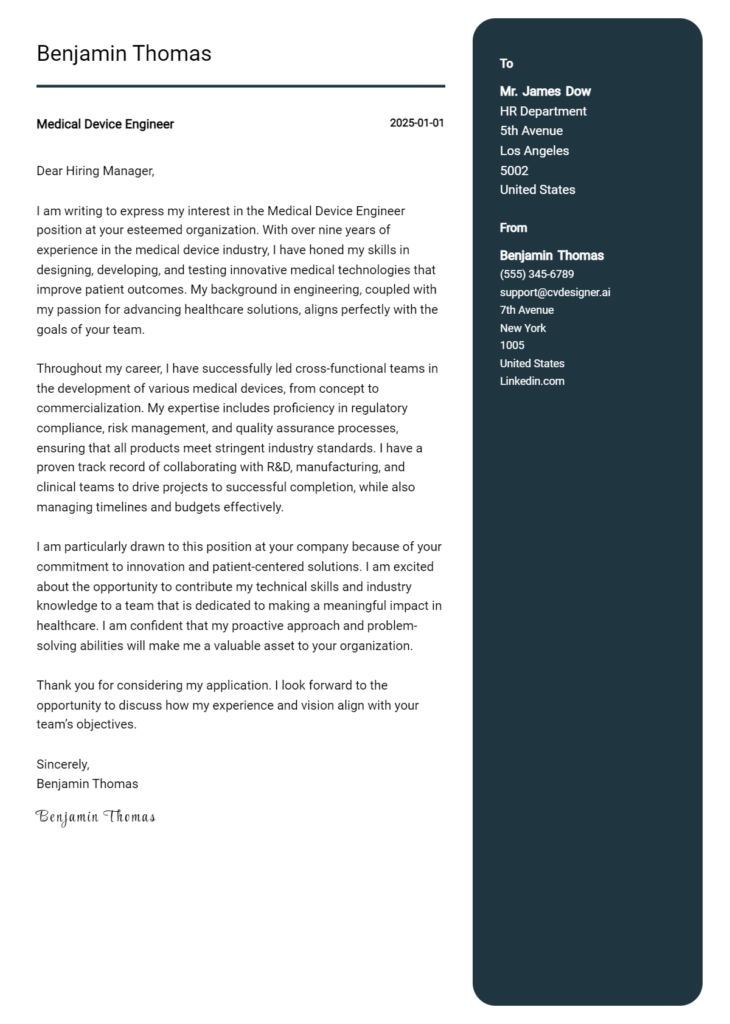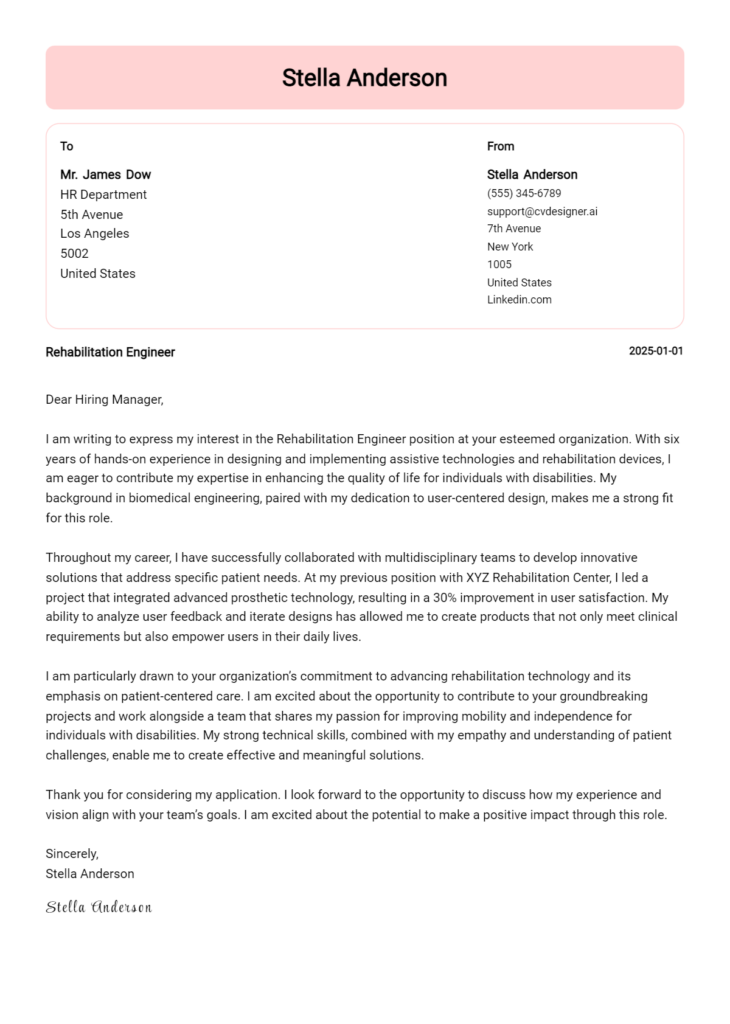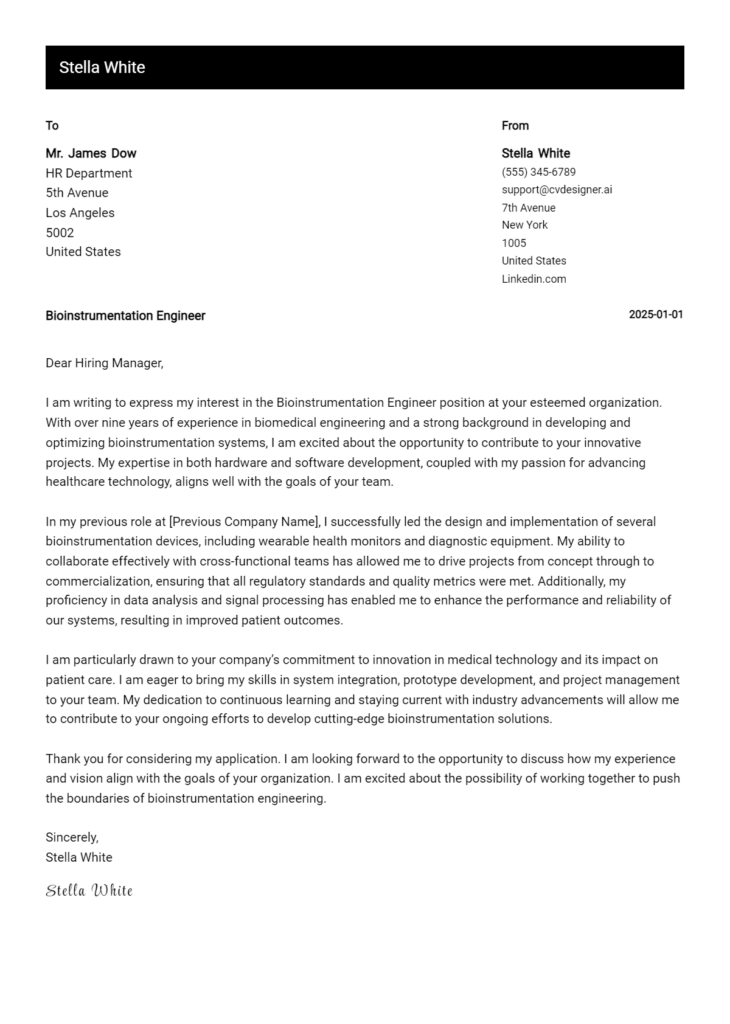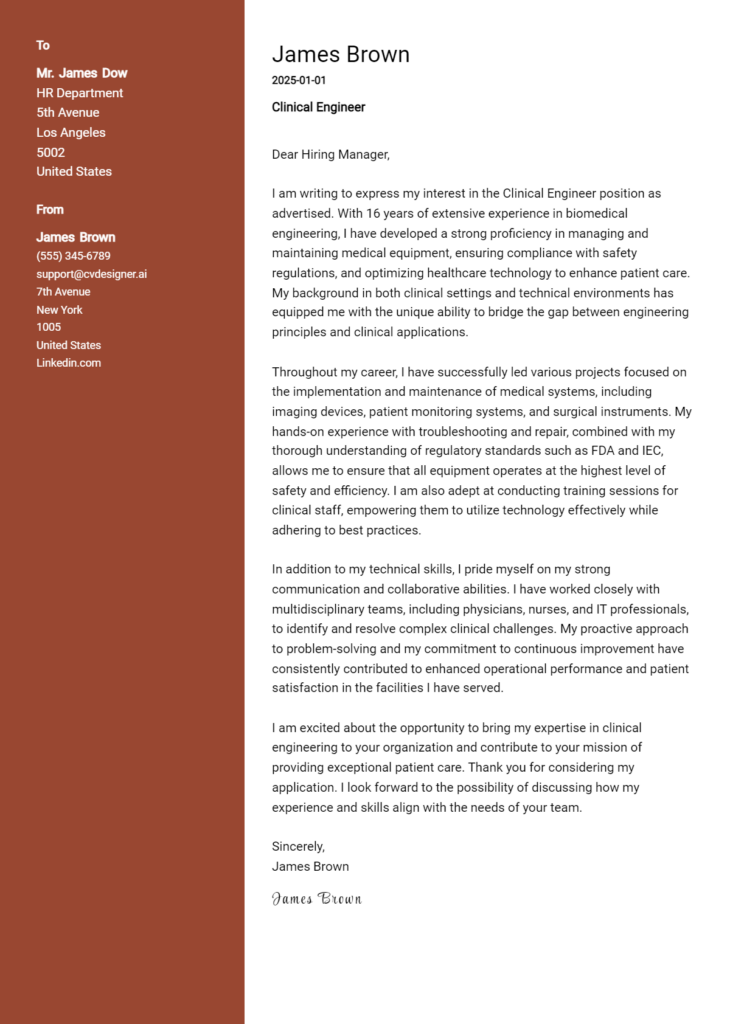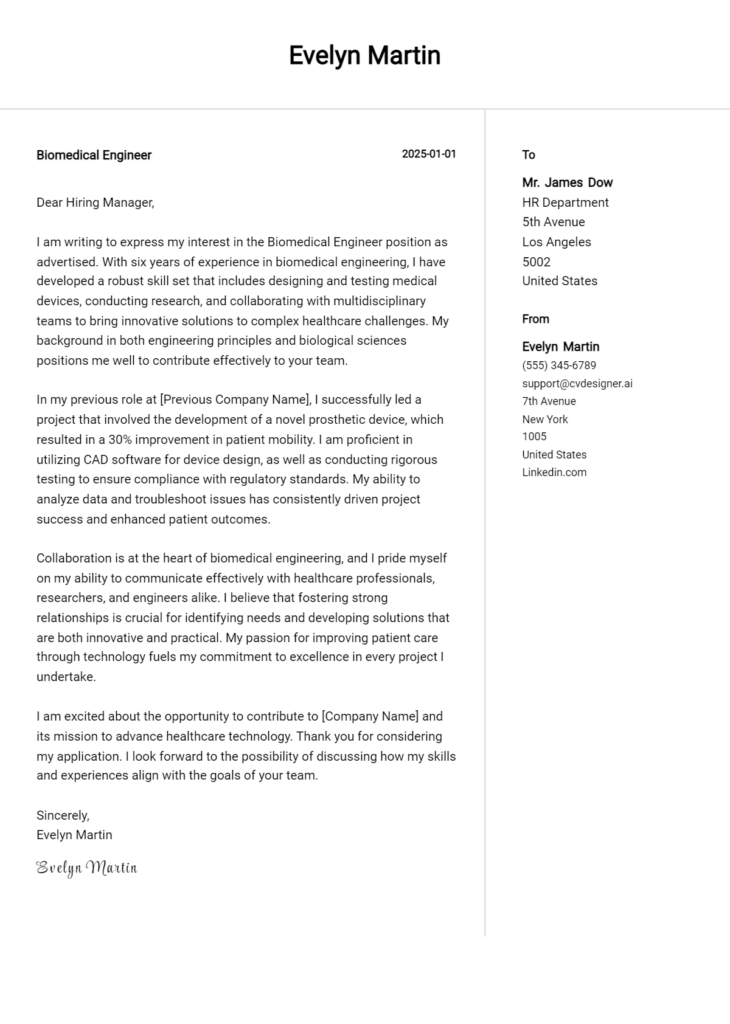Bioinformatics Engineer Cover Letter Examples
Explore additional Bioinformatics Engineer cover letter samples and guides and see what works for your level of experience or role.
How to Format a Bioinformatics Engineer Cover Letter?
Crafting an effective cover letter is essential for a Bioinformatics Engineer, as it serves as your first impression to potential employers. The way you format your cover letter not only reflects your technical expertise but also demonstrates your ability to communicate complex information clearly and concisely. A well-structured cover letter can captivate the hiring manager's attention and illustrate your analytical skills, which are vital in the bioinformatics field.
In this guide, we'll outline the key components of a professional cover letter, providing insights and bioinformatics-specific examples to help you create a compelling document.
We'll focus on the essential elements of a standout cover letter, including:
- Cover Letter Header
- Cover Letter Greeting
- Cover Letter Introduction
- Cover Letter Body
- Cover Letter Closing
Each section plays a crucial role in showcasing your qualifications and professionalism. Let’s break down each part and explain how to make your bioinformatics engineer cover letter shine.
Importance of the Cover Letter Header for a Bioinformatics Engineer
The cover letter header is a crucial component of your application as a Bioinformatics Engineer, as it sets the tone for the rest of the document and conveys professionalism and attention to detail. A well-structured header provides essential contact information, includes the date, and specifies the recipient's details, ensuring clarity and making it easy for hiring managers to reach out. A clear and professional header reflects your organizational skills and shows that you are serious about the position you are applying for.
Here are examples of a strong and a weak cover letter header for a Bioinformatics Engineer role:
Strong Example
John Doe 123 Bioinformatics Lane Cityville, ST 12345 (123) 456-7890 johndoe@email.com [Date] Hiring Manager XYZ Biotech Company 456 Innovation Drive Cityville, ST 12345
Weak Example
john d. bioinformatics job 12345 (123) 456-7890 jd@mail.com [Some date] to whom it may concern
In the strong example, the header is clear, includes all necessary contact information, and is formatted professionally. In contrast, the weak example lacks proper capitalization, specificity, and formal structure, which could leave a negative impression on potential employers.
The Importance of the Cover Letter Greeting
The greeting of a cover letter is crucial as it sets the tone for the entire document. A well-crafted greeting not only establishes a professional demeanor, but it also personalizes the communication by addressing the hiring manager directly. This can make a significant difference in how your application is perceived. Generic greetings can give an impression of a lack of effort or genuine interest in the position. Therefore, taking the time to research the recipient’s name shows initiative and respect. If you cannot find the name, consider using a more specific title such as "Hiring Manager" rather than the overly common "To Whom It May Concern."
When crafting your greeting, aim for a balance of professionalism and warmth. Here are some examples of strong and weak greetings for a Bioinformatics Engineer cover letter:
Strong Greeting Example
Dear Dr. Smith,
Weak Greeting Example
To Whom It May Concern,
The Art of Crafting an Engaging Cover Letter Introduction for a Bioinformatics Engineer
A well-crafted cover letter introduction is crucial for a Bioinformatics Engineer, as it serves as the first impression for the hiring manager. This opening paragraph should not only grab attention but also convey enthusiasm for the role and highlight relevant skills or achievements that align with the job description. A strong introduction can set the tone for the rest of the letter, making it clear why the candidate is a perfect fit for the position. Below are examples of both strong and weak cover letter introductions to illustrate the difference.
Strong Example
Dear [Hiring Manager's Name], I am excited to apply for the Bioinformatics Engineer position at [Company Name], where my extensive background in computational biology and proven success in developing algorithms for genomic data analysis can contribute to advancing your research initiatives. With a Master’s degree in Bioinformatics from [University Name] and over three years of experience in a high-throughput sequencing environment, I have honed my skills in data mining, machine learning, and statistical analysis, positioning me to make an immediate impact on your team.
Weak Example
To Whom It May Concern, I am writing to apply for the Bioinformatics Engineer job. I have a degree and some experience, so I think I would be a good fit. I am familiar with various bioinformatics tools and programming languages.
Purpose of the Cover Letter Body for a Bioinformatics Engineer
The body of the cover letter for a Bioinformatics Engineer plays a crucial role in presenting the candidate's technical expertise, relevant experiences, and the unique value they bring to the organization. This section should effectively highlight specific projects or accomplishments that demonstrate proficiency in bioinformatics tools, programming languages, and data analysis techniques. By detailing successful collaborations on research projects, contributions to software development, or innovative solutions to complex biological problems, the candidate can create a compelling narrative that captures the attention of hiring managers.
Strong Example
I am excited to apply for the Bioinformatics Engineer position at [Company Name]. In my previous role at [Previous Company], I led a project that utilized RNA-Seq data to identify novel biomarkers for early-stage cancer detection. By developing a custom pipeline using Python and R, I successfully reduced data processing time by 30%, enabling our team to provide timely insights to researchers. Additionally, my collaboration with cross-functional teams has honed my ability to communicate complex bioinformatics concepts to non-specialists, ensuring alignment on project goals. I am eager to bring my expertise in data analysis and algorithm development to [Company Name] and contribute to advancing your innovative research efforts.
Weak Example
I want to apply for the Bioinformatics Engineer job at [Company Name]. I have worked in bioinformatics for a few years and know how to use some software tools. In my last job, I did some data analysis, but I don't remember the details. I think I would be a good fit for the team because I am hardworking and willing to learn. I hope to hear back from you soon.
Importance of the Cover Letter Closing for a Bioinformatics Engineer
The closing paragraph of a cover letter is a critical component that reinforces the candidate's qualifications and expresses enthusiasm for the position. It serves as a final opportunity to summarize key strengths, reiterate interest in the role, and encourage the hiring manager to take the next steps, such as reviewing the resume or scheduling an interview. A strong closing leaves a positive impression, while a weak one may fail to engage the reader or convey the candidate's eagerness.
Strong Example
Thank you for considering my application for the Bioinformatics Engineer position. With my extensive experience in genomic data analysis and a strong foundation in computational biology, I am excited about the opportunity to contribute to your team at [Company Name]. I am eager to bring my skills in algorithm development and data interpretation to advance your research initiatives. I look forward to the possibility of discussing how my background aligns with your needs and hope to schedule an interview at your earliest convenience. Thank you for your time and consideration.
Weak Example
I hope you like my application. I think I would be a good fit for the Bioinformatics Engineer role. Please look at my resume. I guess we can talk later if you want to.
Crafting a compelling cover letter is essential for any Bioinformatics Engineer looking to stand out in a competitive job market. An effective cover letter not only introduces you to potential employers but also showcases your unique qualifications and enthusiasm for the field. Highlighting your technical skills, problem-solving capabilities, understanding of the Software Development Life Cycle (SDLC), ability to work in a team, and commitment to continuous learning can significantly enhance your chances of landing an interview. The following tips will guide you in composing an impactful cover letter that resonates with hiring managers.
Tips for Writing an Effective Cover Letter for Bioinformatics Engineer
Showcase Technical Skills: Begin your cover letter by clearly outlining your technical skills relevant to bioinformatics. Mention programming languages (such as Python, R, or Java), data analysis tools (like Bioconductor or Galaxy), and any experience with databases (like SQL or NoSQL). Use specific examples of projects where you applied these skills, which can help demonstrate your proficiency and make your application memorable.
Highlight Problem-Solving Abilities: Employers in bioinformatics value engineers who can tackle complex biological data challenges. Use your cover letter to provide examples of how you approached a significant problem and the innovative solutions you implemented. This not only showcases your analytical thinking but also your ability to contribute meaningfully to research or development projects.
Demonstrate SDLC Knowledge: Understanding the Software Development Life Cycle (SDLC) is crucial for a Bioinformatics Engineer. Discuss any experience you have with various phases of the SDLC, emphasizing your role in the design, development, testing, and deployment of bioinformatics software tools or applications. Highlighting this knowledge shows that you are well-versed in project management and can collaborate effectively with other developers and stakeholders.
Emphasize Teamwork: Bioinformatics projects often involve interdisciplinary teams. Use your cover letter to talk about your experience working collaboratively with biologists, statisticians, and other engineers. Illustrate how you contributed to a team dynamic, resolved conflicts, or shared knowledge, demonstrating your ability to function well in a collaborative environment.
Express Passion for Continuous Learning: The field of bioinformatics is rapidly evolving, and a commitment to continuous learning is key to staying relevant. Mention any courses, certifications, or workshops you've attended, as well as any self-directed learning initiatives. This not only highlights your dedication to personal and professional growth but also your proactive approach to keeping your skills sharp in this dynamic field.
By incorporating these tips into your cover letter, you can create a powerful narrative that showcases your qualifications as a Bioinformatics Engineer. For additional guidance, consider using cover letter templates or a cover letter builder to help streamline the writing process.
Common Mistakes to Avoid in a Bioinformatics Engineer Cover Letter
Crafting a compelling cover letter is essential for standing out in the competitive field of bioinformatics engineering. Avoiding common mistakes can significantly enhance your chances of landing an interview. Here are some pitfalls to watch out for:
Generic Content: Using a one-size-fits-all approach can make your cover letter forgettable. Tailor your letter to the specific job and company, highlighting relevant skills and experiences.
Lack of Technical Detail: Failing to mention specific bioinformatics tools or technologies you’ve worked with can weaken your application. Be sure to include relevant software and programming languages in your letter.
Overly Formal Language: While professionalism is important, using overly complex language can alienate readers. Aim for clear and concise language that reflects your genuine interest in the position.
Neglecting to Showcase Achievements: Simply listing responsibilities can make your experience seem bland. Instead, highlight specific achievements and contributions you’ve made in previous roles.
Ignoring Formatting Guidelines: Poorly formatted letters can distract from your qualifications. Follow a clear cover letter format to ensure readability and professionalism.
Typos and Grammatical Errors: Mistakes in spelling or grammar can undermine your attention to detail. Always proofread your letter and consider asking a colleague for feedback.
Not Including a Call to Action: Failing to express your enthusiasm for the next steps can leave your letter feeling incomplete. Conclude with a strong call to action, inviting the employer to discuss your application further.
By avoiding these common mistakes and learning from cover letter examples, you can create a more impactful cover letter that highlights your qualifications and enthusiasm for the role of Bioinformatics Engineer.
Cover Letter FAQs for Bioinformatics Engineer
What should I include in my cover letter for a Bioinformatics Engineer position?
In your cover letter, focus on highlighting your technical skills, educational background, and practical experience relevant to bioinformatics. Start with a strong introduction that mentions the specific position you're applying for. Include key skills such as programming languages (Python, R), experience with bioinformatics tools (BLAST, Bowtie), and familiarity with databases (GenBank, Ensembl). Mention any relevant projects or research you've conducted, showcasing your problem-solving abilities and analytical thinking. Finally, express your enthusiasm for the role and the company, demonstrating your understanding of their work and how your background aligns with their goals.
How do I tailor my cover letter for a specific Bioinformatics Engineer job?
To tailor your cover letter, carefully read the job description and identify the key responsibilities and skills required. Match your qualifications and experiences with these requirements. For instance, if the job emphasizes experience with next-generation sequencing data analysis, highlight your relevant projects or coursework. Use specific examples to illustrate how your skills align with the company's needs. Research the organization to incorporate their values or recent projects into your letter, showing that you've done your homework. This personalized approach demonstrates your genuine interest in the position and sets you apart from generic applications.
How long should my cover letter be for a Bioinformatics Engineer position?
Your cover letter should be concise, ideally one page in length. Aim for three to four short paragraphs that effectively convey your qualifications, experiences, and enthusiasm for the position. Use a clear structure: start with an engaging introduction, followed by a paragraph detailing your relevant skills and experiences, and conclude with a strong closing statement that reiterates your interest. Avoid overwhelming the reader with excessive details or jargon; instead, focus on clear and impactful language that highlights your suitability for the role. This approach ensures your cover letter is both informative and easy to read.
What is the best way to conclude my cover letter for a Bioinformatics Engineer role?
Conclude your cover letter with a strong closing statement that reinforces your enthusiasm for the position and your desire for an interview. Thank the hiring manager for considering your application and express your eagerness to discuss how your skills and experiences align with the team's needs. You might say something like, "I am excited about the opportunity to contribute to [Company Name] and would love to discuss my background in bioinformatics further." Additionally, include your contact information and express your willingness to provide further details or references if needed. A confident, positive closing leaves a lasting impression.
Build your Cover Letter in minutes
Use an AI-powered cover letter builder and have your letter done in 5 minutes. Just select your template and our software will guide you through the process.


